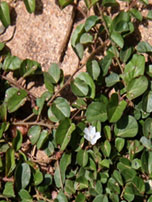Vishnukranti

Botanical Name : Evolvulus nummularius (L.) L.
Family : Convolvulaceae
Names in different Indian languages :
English : Round leaf Bindweed
Malayalam : vishnukranta
Sanskrit : Vishnukranti
Synonyms :
Akhukarni, mushakarni
Morphology :
Perennial herb. Stems prostrate, pubescent, rooting at nodes. Leaves orbicular to orbicular-obovate, 5-20 mm long and broad, apex obtuse or retuse, base truncate to subcordate, glabrous or sparsely pubescent beneath; petiole 1-8 mm long, pubescent, canaliculate above. Flowers solitary or rarely paired, axillary; peduncles up to 5 mm long, recurving. Sepals ovate to elliptic-ovate, 2.5-3.0 x 1.5 mm, subacute to acute, pubescent or glabrescent with ciliate margins. Corolla white, subrotate, 4.5 mm long, 6 mm wide, deeply lobed; lobes obovate, 1.5-2.5 mm long, 1.0-1.5 mm broad. Capsule globose, 3-4 mm in diameter, 1-locular, bivalved, (2-)4-seeded. Seeds subglo-bose, 1.5-2.0 mm long, brown to black, shiny.
Distribution & Habitat :
This species is indigenous to tropical America as well as tropical Africa and Madagascar and is introduced in India. It reaches its southernmost point of distribution in the most tropical part of the FSA area, namely northern KwaZulu-Natal. It seems to occur mostly in short grassland on sandy soils. Also found in dry forest and dense thicket or even on waste ground.
Chemical constituents :
β sitosterol, d mannitol, oleanolic acid, stigmasterol, ursolic acid